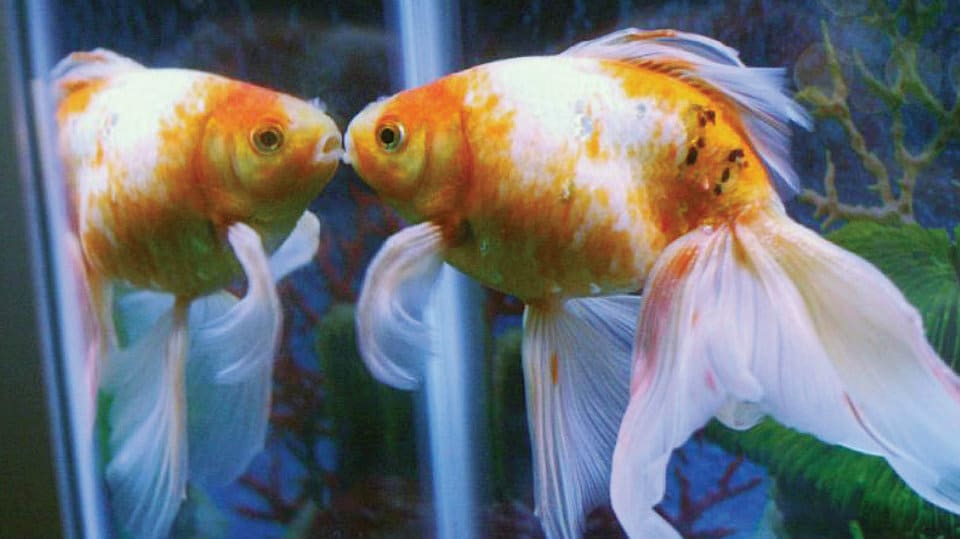By Maneka Gandhi
In this week’s Pet Talk, Maneka tells about reducing aggression between two fish in aquarium and gives infomation about snakes.
How can I decrease the aggression between two fish in my aquarium?
The ideal situation for incorporating two or more aggressive fish of the same species is to add them simultaneously. This way, the fish can establish their own territories with minimal conflict. When you add an aggressive fish to an aquarium with an already-established, territorial fish of the same species, attacks are practically guaranteed.
Because the already-established fish considers the entire aquarium to be its territory, it will fight to protect its territory when new fish are introduced. You could enlarge the aquarium and reintroduce all the fish in it simultaneously.
Try the “mirror trick” when acclimating a new aggressive fish to an established aquarium. Simply place a mirror outside of the aquarium so the established aggressive fish can see itself. This fish will then be preoccupied with its own reflection, giving the new fish time to establish its territory without excessive hostility.
Since aggressive fish need their own territories to “guard,” be sure that your aquarium contains many hiding places that can serve as individual territories. If space permits, you can add large amounts of rock to your aquarium, then carefully arrange it to create lots of caves and hiding spaces. If you already have rocks in your aquarium, rearrange them. This will effectively eliminate established territories and give all fish an equal opportunity to establish new territories.
Aggressive fish will also fight for dominance over food. Because of this, it’s a good idea to provide more than one food source in your aquarium.
The best is NOT to keep aquariums. These fish you have for show could have served a very useful purpose in their natural habitat. Secondly, don’t put aggressive fish into the aquarium. Does it give you pleasure to see them fight and harm each other?
Measures to cure snake bites in animals?
If you can identify the snake, it is helpful. It is NOT necessary to kill the snake to identify it. However, do not get close enough to the snake to put yourself at risk of getting bitten. You should attempt to keep your pet calm and contact a veterinarian. Be aware that a pet will be in great pain after being bitten. Use caution when handling your pet. The painful bite may cause your pet to snap at you or bite you when being handled. If you need to lift your pet into a car, a muzzle, or wrapping the pet in a thick comforter, may be necessary to keep you safe. Cats should be transported in a cat carrier or box if possible.
There are some things you should NOT do, as these treatments can cause harm to your pet or harm to you.
- Do not put any sort of tourniquet on your pet; II. Do not apply ice on the bite; III. Do not make any cuts into the skin; IV. Do not try to suck the poison out; V. Do not apply a compression bandage to the wound.
Once you get your pet to a veterinary hospital, your veterinarian will advise you on the best tests and treatment for your pet based on his/ her condition. Your veterinarian may want to look at a blood smear to help determine if it was in fact a venomous snake that bit your pet. Often, but not always, the red blood cells of a pet that was bitten will look spiky when viewed under a microscope. Since snake venom can cause a bleeding disorder, your veterinarian may want to test your pet’s clotting times. Other tests that may be performed include a CBC, a chemistry panel, a urinalysis, blood pressure, and an EKG. Your veterinarian will treat your pet based on how severely he or she is affected. Treatments may include pain medication, intravenous fluids, anti-histamines, steroids, antibiotics, and antivenin.
Not all snakebites require antivenin. Antivenin is useful in cases where your pet’s clotting times are affected. The antivenin can help prevent bleeding disorders. Antivenin can also help reduce the amount of swelling. It is best if antivenin is administered within four to six hours once a pet is bitten. Pets can have a serious allergic reaction to antivenin. Your veterinarian will take precautions to minimise the chance of an allergic reaction developing if this product is administered.
How to tell if a snake is dangerous or not?
Pupil size, for example, can often tell you a poisonous snake from a non-poisonous snake. Most poisonous snakes have a pupil that resembles a cat’s; an oblong shape with peaked ends, like a slit in the centre of the eye. Non-venomous snakes usually have round pupils.
Colour can be a good indicator of a venomous snake, though again, there are always exceptions to the rule. Most solid coloured snakes are not poisonous. The most colourful the snake, the more wary of it you should be. Venomous snakes also have a more triangular head, whereas non-venomous snakes will have a rounded jaw. The shape of the face has to do with the location of the venom sacks, so triangular = beware! Venomous snakes may have a divot in between their eyes for heat sensing. This physical attribute is most present in vipers and is a good indication of poisonous standing.
Behaviour can also indicate poisonous or non-poisonous. Water snakes, for example, come in both varieties, but only poisonous snakes will swim with their entire bodies visible on the water. This is because venomous snakes swim with their lungs inflated, whereas a harmless water snake will swim with its body submerged.
However, most venomous snakes stay away from human habitations. The non-poisonous ones come in search of mice and lizards.
Measures to treat injured snake?
We most commonly see snakes that have suffered a bite wound from a dog or a cat or have been injured in the road. Obvious signs of injury include wounds along the body or if a snake seems unable to move part of its body. For example, the front half of the snake moves, but the back half appears limp. Small snakes can also become stuck to glue traps.
- a) Find a container big enough to hold the snake and poke holes in the lid (before putting the snake inside).
- b) Alternatively, use a pillowcase to secure the snake.
If you see a snake in need of help, here are some pointers about handling and transporting:
- Try to gently scoop the snake into a container with a tight-fitting lid. Be sure to poke air holes in the container.
- Another option is to scoop the snake into a pillow case and knot the open end.
iii. Although most snakes rarely bite, it may try to do so if it is scared and injured. Rather than picking the snake up with your hand, try gently sliding the snake into the container or pillowcase using a stick or other object.
- If the snake is stuck to a glue trap, do not try to remove it yourself in order to avoid damaging its skin.
- It is not necessary to try to feed the snake or offer water, and it is best not to try to treat any injury you might observe.
- If possible, wounds should be washed with copious amounts of warm, soapy water, using an antibacterial soap.
vii. If the wound is very deep or is around the face or eyes, it is better to have a professional perform the cleaning.
viii. Next, clean the wound with dilute povidone iodine solution, diluted to iced-tea colour, flushing the wound several times, and then rinsing well with clean water.
- For superficial wounds, apply a light layer of antibiotic ointment and leave uncovered.
- It is difficult to apply a bandage to reptile skin without causing additional trauma.
- After a bite, keep the wound clean until it has healed.
After a wound has healed, it may result in dysecdysis (difficulty shedding) when it comes time for the next shed. With each successive shed, the scar should become less and less visible; however, some evidence of a wound may remain for quite some time or forever, depending on the severity of the injury.
If a wound is severe and if you can see bone or internal organs or if it is a large, gaping wound, you should take your injured animal to the vet for assistance. Large bite wounds should not be sutured usually, as bites are usually infected and should be treated as open wounds.
At any time, if you feel that the injury is not healing properly, or if the animal goes off feed, or if you notice any changes that concern you, please contact the vet immediately so that it can be properly evaluated and treated.








Recent Comments